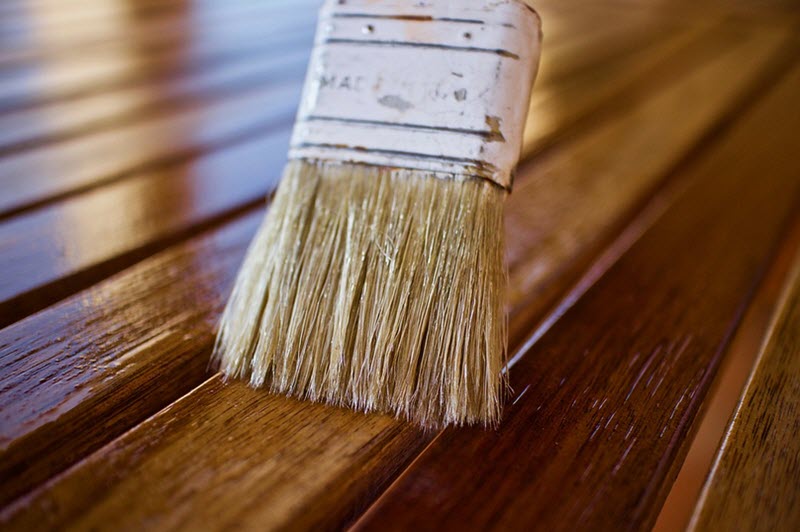Linseed oil comes from the seeds of the flax plant and is great for treating wood using the hand-rubbing method, provided you have plenty of time to devote to the treatment. The linseed oil saturates deep into the wood grain and will protect against both scratches and similar wear and tear. The finished result looks great as the oil brings out the depth of colour and texture or the wood. When properly applied, linseed will result in a satin-like finish that really brings out the beauty of the wood underneath. Also, wood treated with linseed oil is also better at handling changes in humidity.
Unlike certain other types of wood treatment products, working with linseed oil is safe. You could even buy food-grade linseed oil if you wanted to. Linseed oil is included in many food and skincare products for humans and pets, and organic linseed oil is available.
In the 20th century, linseed oil was often turned down in favour of synthetic alkyd resins such as polyurethane, synthetic lacquer and acrylic varnish. Today, linseed oil is making a comeback, and a lot of people are re-discovering what this non-petroleum, non-toxic oil has to offer.
Unlike products that form a film on top of the wood, linseed oil will seep into the grain. If there is a scratch or dent in the future, it can be sanded out.
Linseed oil – a natural product for your house
Linseed oil comes from the seeds of the flax plant (Linum usitatissimum). This plant has been farmed for thousands of years. In addition to producing oil-rich seeds, this plant also produces fibres that can be turned into ropes, textiles (linen) and even paper. It is thus both a food crop and a fibre crop.
The origins of the species Linum usitatissimum remains unclear, but it was probably domesticated from the wild Linum bienne.

Safety precautions
Linseed oil is flammable, and rags containing linseed oil can start burning even without any external spark. It is the drying process that is exothermic. Rags with linseed oil should therefore be stored in a fireproof container with a close-fitting lid on (to limit the supply of oxygen). For additional safety, you can soak the rags in water before putting them in the can.
Raw vs. Boiled vs. Polymerized linseed oil
Raw linseed oil works great, but it can take several weeks for each new coat to cure, and treating wood with raw linseed oil is therefore a time-consuming process. So-called boiled linseed oil from the store is typically not boiled, despite the name, but contains added drying agents that makes it cure faster. Polymerized linseed oil has been heated up to circa 300 degrees C.
Raw linseed oil
Raw linseed oil is the purest version of linseed oil, and the kind we happily put in our food. Raw linseed oil is used to treat both wood and leather. When applied to wood, it can take anywhere from two weeks to over two months for it to cure properly, depending on the environment and how thick you put it on.
Boiled linseed oil
The product called boiled linseed oil (BLO) will cure much quicker than raw linseed oil and is therefore more convenient to use. The product sold as boiled linseed oil in the store is most likely not boiled at all or even heated. Instead drying agents – either petroleum-based or metals – have been added. Of course, adding such agents to linseed oil can turn it into a not-so-safe nor environmentally friendly product.
Examples of petroleum-based compounds that will make linseed oil cure quicker are naphtha, mineral spirits and dipropylene glycol monomethyl. Examples of metals that will achieve the same are cobalt and manganese, which are both toxic to humans in fairly small amounts.
So called boiled linseed oil will emit some volatile organic compounds when drying.
Polymerized linseed oil
Polymerized linseed oil dries faster than raw linseed oil, but without releasing any of the volatile organic compounds emitted by BLO.
Polymerized linseed oil is created by heating raw linseed oil to about 300 degrees C (575 degrees F) for several days in the absence of oxygen. A polymerization reaction takes place, which increases the viscosity of the linseed oil.
The downsides of using linseed oil to treat wood
- You will need to re-oil the wood occasionally.
- The wood will yellow slightly over time. If this is good or bad is a matter of preference.
- Changes in temperature and/or humidity can make the wood ”bleed” some oil.
- Wood treated with linseed oil is still susceptible to water rings. (Although, linseed oil can be used alongside certain other finishes, including wax, to further protect the wood.)
- Wood treated with linseed oil will be more susceptible to scratches than wood with a hard coat finish, e.g. hard coat lacquer. (However, if a scratch does appear on a hard coat finish, it will be more difficult to fix that problem. For wood treated with just linseed oil, it is fairly easy to sand away the scratch.)
- Linseed oil is not good at protecting wood from coloured liquids, e.g. red beet juice.

